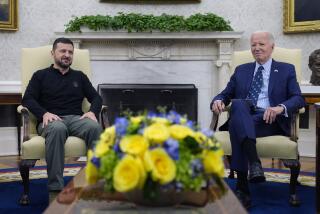U.S. risks wasting billions more in Afghanistan aid, report says
Reporting from Washington — Reviewing the multibillion-dollar U.S. aid program in Afghanistan two years ago, Secretary of State Hillary Rodham Clinton pronounced it a “heartbreaking” failure and promised to make a successful aid program the centerpiece of a revamped strategy to defeat the Taliban.
Recent U.S. government reports suggest that the Obama administration instead doubled down on a flawed strategy, pouring large sums into projects that have fueled corruption, distorted local economies and left Afghanistan with technology it won’t be able to maintain after NATO forces leave.
The bipartisan Congressional Commission on Wartime Contracting in Iraq and Afghanistan said in a report this month that “overly ambitious proposals, incomplete analysis, poor planning, weak coordination and inadequate follow-through by federal officials” risked wasting billions more.
The Afghan economy is so dependent on military spending and international aid that it could plunge into depression in 2014 when U.S. forces are scheduled to depart, concludes a two-year study released last week by the Democratic majority of the Senate Foreign Relations Committee. The committee chairman, John F. Kerry of Massachusetts, is a close ally of the Obama administration.
The administration is opening a review of the size of a troop withdrawal amid widespread doubts about the cost and purpose of the war. Doubts about the aid effort are likely to bolster calls for a more rapid pullout. Some analysts contend that the torrent of aid undermines the counterinsurgency effort by creating a culture of entitlement and corruption.
“There is this assumption that if we spend a lot of money on them, they’ll like us,” said Carol Lancaster, a former deputy administrator of the U.S. Agency for International Development, who is now dean of Georgetown University’s School of Foreign Service. “I’m not sure what you gain by spending a lot of money that doesn’t produce sustainable and beneficial change.”
State Department and White House officials disputed that civilian aid to Afghanistan on their watch had been a failure.
U.S. assistance has helped Afghans and saved the lives of American troops, said Rajiv Shah, administrator of USAID, which dispenses much of the money. “The Senate report has some misperceptions of the overall effort,” Shah told reporters, though he did not dispute its central conclusions.
Starting in 2002, the George W. Bush administration spent about $10.7 billion on civilian aid in Afghanistan. Clinton declared in March 2009, soon after the Obama administration took office, that many of the programs didn’t work.
“We are looking at every single dollar as to how it’s spent and where it’s going, and trying to track the outcomes,” Clinton said. “We want to see real results.”
The Obama administration spent $7 billion more in 2009 and 2010, and is slated to spend an additional $3.2 billion this year. But government studies indicate that the fundamental structure of the aid programs has not changed.
The World Bank estimates that 97% of Afghanistan’s economic output is from spending related to the international military and civilian presence. Donors finance most Afghan government operations, the Senate study says. Higher salaries paid by foreign contractors and international aid groups draw away the country’s best-educated technocrats.
Some of the aid clearly has done good, funding the construction of schools, hospitals and highways. But security concerns keep U.S. officials from visiting some projects, government reports say. Many experts believe a portion of aid is siphoned directly to the Taliban, often as protection money.
Last year, an audit by USAID’s inspector general concluded that as much as $5 million of a $349-million project funded by DAI, a Maryland-based firm that is one of USAID’s largest contractors, was paid by subcontractors to the Taliban.
Separately, DAI fired 22 Afghan employees over allegations of corruption in the program, which hands out grants for small projects including providing irrigation, refurbishing shops and bazaars, and building farm-to-market roads.
Despite a promised increase in the number of diplomats and U.S. civil servants, the Senate report finds, the aid program continues to rely on a few contractors, including firms that have been criticized for mismanagement and, in one case, fined for fraud.
The Senate report also raises questions about the large portion of money directed to short-term stabilization programs to win over civilians in the south and east, where the heaviest fighting has taken place. A recent study of Helmand province found that villagers were supporting the Taliban not because they were poor, but because they were scared and needed security.
Analysts point to the Kajaki dam, which produces electricity for Kandahar and Helmand provinces, as a case study in what has gone wrong. A $100-million restoration project has been beset by cost overruns and rife with no-bid contracts, according to government audits.
Mark Moyar, a former professor at the Marine Corps University and a consultant to U.S. forces in Afghanistan, wrote in an article for the website Long War Journal in March that half the electricity ended up going to insurgent-controlled areas, “enabling the Taliban to issue electric bills to consumers and send out collection agents with medieval instruments of torture to ensure prompt payment.”
More to Read
Sign up for Essential California
The most important California stories and recommendations in your inbox every morning.
You may occasionally receive promotional content from the Los Angeles Times.











